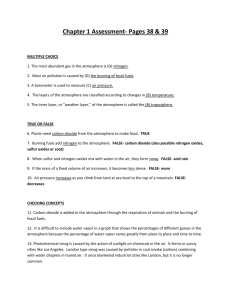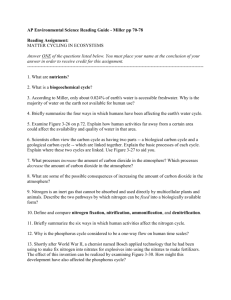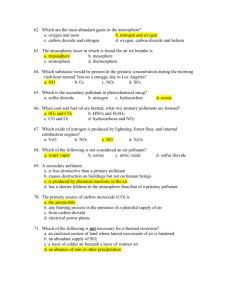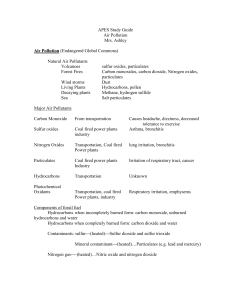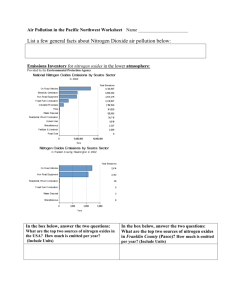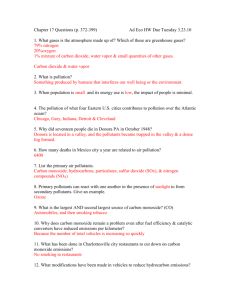Sulfur dioxide and oxides of nitrogen
advertisement
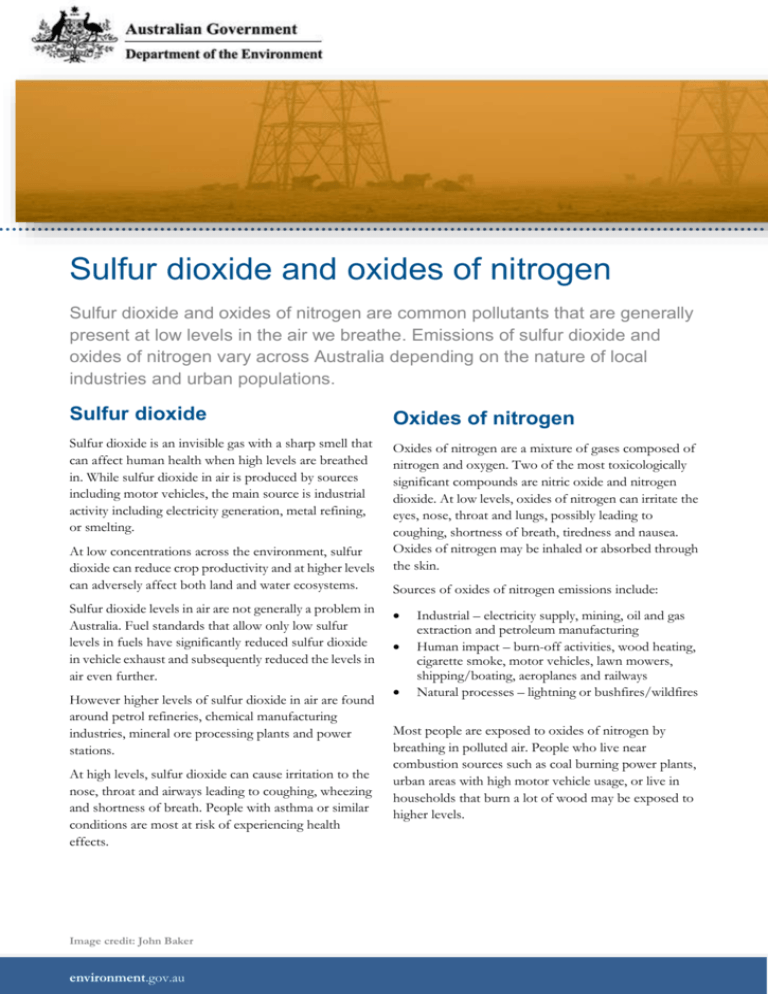
Sulfur dioxide and oxides of nitrogen Sulfur dioxide and oxides of nitrogen are common pollutants that are generally present at low levels in the air we breathe. Emissions of sulfur dioxide and oxides of nitrogen vary across Australia depending on the nature of local industries and urban populations. Sulfur dioxide Oxides of nitrogen Sulfur dioxide is an invisible gas with a sharp smell that can affect human health when high levels are breathed in. While sulfur dioxide in air is produced by sources including motor vehicles, the main source is industrial activity including electricity generation, metal refining, or smelting. Oxides of nitrogen are a mixture of gases composed of nitrogen and oxygen. Two of the most toxicologically significant compounds are nitric oxide and nitrogen dioxide. At low levels, oxides of nitrogen can irritate the eyes, nose, throat and lungs, possibly leading to coughing, shortness of breath, tiredness and nausea. Oxides of nitrogen may be inhaled or absorbed through the skin. At low concentrations across the environment, sulfur dioxide can reduce crop productivity and at higher levels can adversely affect both land and water ecosystems. Sulfur dioxide levels in air are not generally a problem in Australia. Fuel standards that allow only low sulfur levels in fuels have significantly reduced sulfur dioxide in vehicle exhaust and subsequently reduced the levels in air even further. However higher levels of sulfur dioxide in air are found around petrol refineries, chemical manufacturing industries, mineral ore processing plants and power stations. At high levels, sulfur dioxide can cause irritation to the nose, throat and airways leading to coughing, wheezing and shortness of breath. People with asthma or similar conditions are most at risk of experiencing health effects. Image credit: John Baker environment.gov.au Sources of oxides of nitrogen emissions include: Industrial – electricity supply, mining, oil and gas extraction and petroleum manufacturing Human impact – burn-off activities, wood heating, cigarette smoke, motor vehicles, lawn mowers, shipping/boating, aeroplanes and railways Natural processes – lightning or bushfires/wildfires Most people are exposed to oxides of nitrogen by breathing in polluted air. People who live near combustion sources such as coal burning power plants, urban areas with high motor vehicle usage, or live in households that burn a lot of wood may be exposed to higher levels. Governments and industry need to work together to develop solutions to minimise air pollution to protect the health of the environment and of local communities. State and territory governments have primary responsibility for managing air pollution. They regulate pollutants, including sulfur dioxide and oxides of nitrogen, from a range of sources including mines and power stations. The Australian Government also manages sulfur dioxide emissions on a national scale through implementing national fuel quality and vehicle emissions standards. National Pollutant Inventory The National Pollutant Inventory (NPI) is an internet database that provides publicly available information on pollutants to the environment. Facilities that meet NPI reporting thresholds are required to report their annual emissions of 93 pollutants to their state or territory NPI team, who assess the reports for accuracy and quality and submits the facility data to the Australian Government for publication on the NPI website (www.npi.gov.au). This allows communities to view annual data regarding the emission of pollutants that may affect them locally. The NPI reports on emissions of sulfur dioxide and oxides of nitrogen. As reported to the NPI, the highest emissions to air of sulfur dioxide include basic non-ferrous metal manufacturing, for example refineries, electricity generation and fuel combustion. The highest emissions to air of oxides of nitrogen include electricity generation, motor vehicles and burning for fuel reduction or regeneration. Figure 1 shows the total emissions of sulfur dioxide and oxides of nitrogen as reported to the NPI over the last ten reporting periods. environment.gov.au 1600 1400 1200 Kilotonnes What are governments doing to combat sulfur dioxide and oxides of nitrogen? 1000 800 Sulfur dioxide 600 400 Oxides of nitrogen 200 0 Reporting year National Clean Air Agreement The Australian Environment Minister, the Hon. Greg Hunt MP, has secured the agreement of all Australian Environment Ministers to establish a National Clean Air Agreement (Agreement) to ensure that the community continues to enjoy clean air and address the impacts on human health and the environment. Australian Environment Ministers are working to develop an Agreement by July 2016. Feedback has been sought from the community on the Working towards a National Clean Air Agreement – Discussion Paper. This included consideration of priorities such as strengthening ambient air quality reporting standards for sulfur dioxide and nitrogen dioxide under the Ambient Air Quality National Environment Protection Measure, recognising that high levels of sulfur dioxide and nitrogen dioxide emissions are of environmental and health concern to local communities. The Agreement will focus on actions to reduce air pollution and improve air quality through cooperative action between industry and government at the national, state and local level. The Agreement is being designed to incorporate a range of existing, new and complementary measures to improve Australia’s air quality. Further information can be found via: http://www.environment.gov.au/national-clean-a ir-agreement. National Environmental Science Programme Environment Ministers are considering options to further mitigate PM pollution from wood heaters. The Australian Government is supporting practical and applied environmental research under the National Environmental Science Programme, including $8.8 million in funding for ‘Clean Air and Urban Landscapes Hub’. This Hub will focus on increasing the understanding of the environmental and social impacts of air pollution in urban and peri-urban areas. Review of Fuel Quality Standards Act 2000 National ambient air quality standards The review of the Act will commence in June 2015 and report in late 2015. The review will investigate and report on best management practices for fuel quality. A subsequent stage will be to consider current fuel quality standards, including the petrol and diesel standards, to ensure that they deliver the best possible air quality outcomes. The National Environment Protection (Ambient Air Quality) Measure (NEPM) establishes national ambient air quality standards and provides a national framework for monitoring and reporting on six common air pollutants, including sulfur dioxide and nitrogen dioxide. Environment Ministers are considering changes to strengthen the Ambient Air Quality NEPM to allow stronger actions to mitigate sulfur dioxide and nitrogen dioxide pollution. The Australian Government has commenced a review of the Fuel Quality Standards Act 2000 to ensure that Australian motorists have access to high quality fuel, which will continue to deliver improved air quality outcomes. © Commonwealth of Australia, 2015. Non-road spark ignition engines and equipment Emissions from non-road spark ignition engines and equipment can be a significant source of sulfur dioxide and oxides of nitrogen in some urban air-sheds. These engines cover a wide range of petrol powered equipment, including marine outboard engines and gardening equipment such as leaf blowers and chain saws. This equipment is a significant source of pollution because it doesn’t have the same advanced emission controls found in on-road engines. Environment Ministers are considering additional work to further mitigate sulfur dioxide and oxides of nitrogen pollution from non-road spark ignition engines and equipment. Wood heaters Emissions from wood heaters contain sulfur dioxide and oxides of nitrogen, as well as other pollutants, which can be significant contributors to air pollution, particularly in the cooler months. The Australian Government has undertaken a number of programmes with a focus on wood heaters and environment.gov.au This fact sheet is licensed by Commonwealth of Australia under a Creative Commons Attribution 3.0 Australia licence. The views and opinions expressed in this publication are those of the authors and do not necessarily reflect those of the Australian Government or the Minister for the Environment. Note: While the Commonwealth has made reasonable efforts to ensure the accuracy, correctness or completeness of the material, the Commonwealth does not guarantee, and accepts no liability whatsoever arising from or connected to, the accuracy, reliability, currency or completeness of this material.
